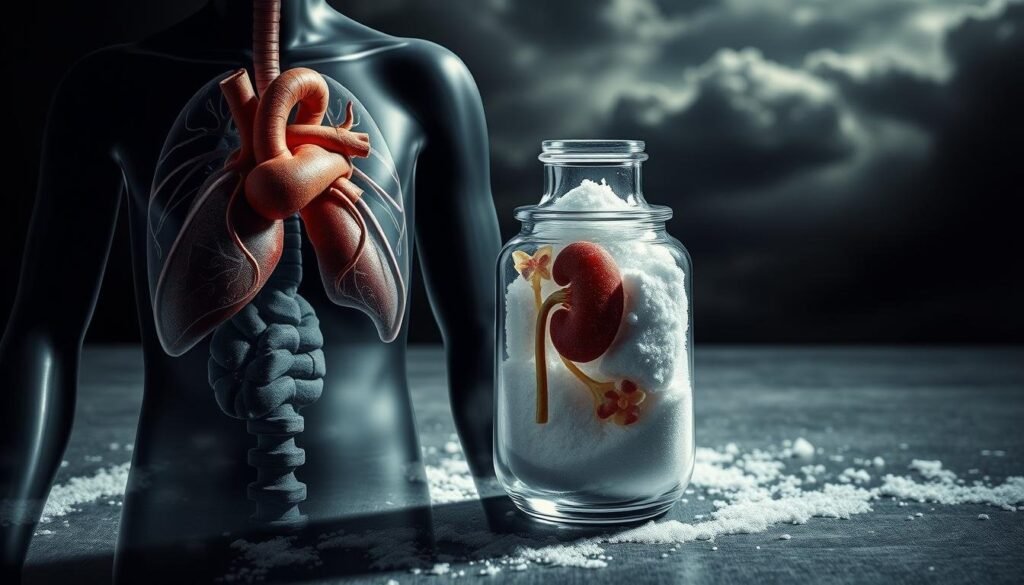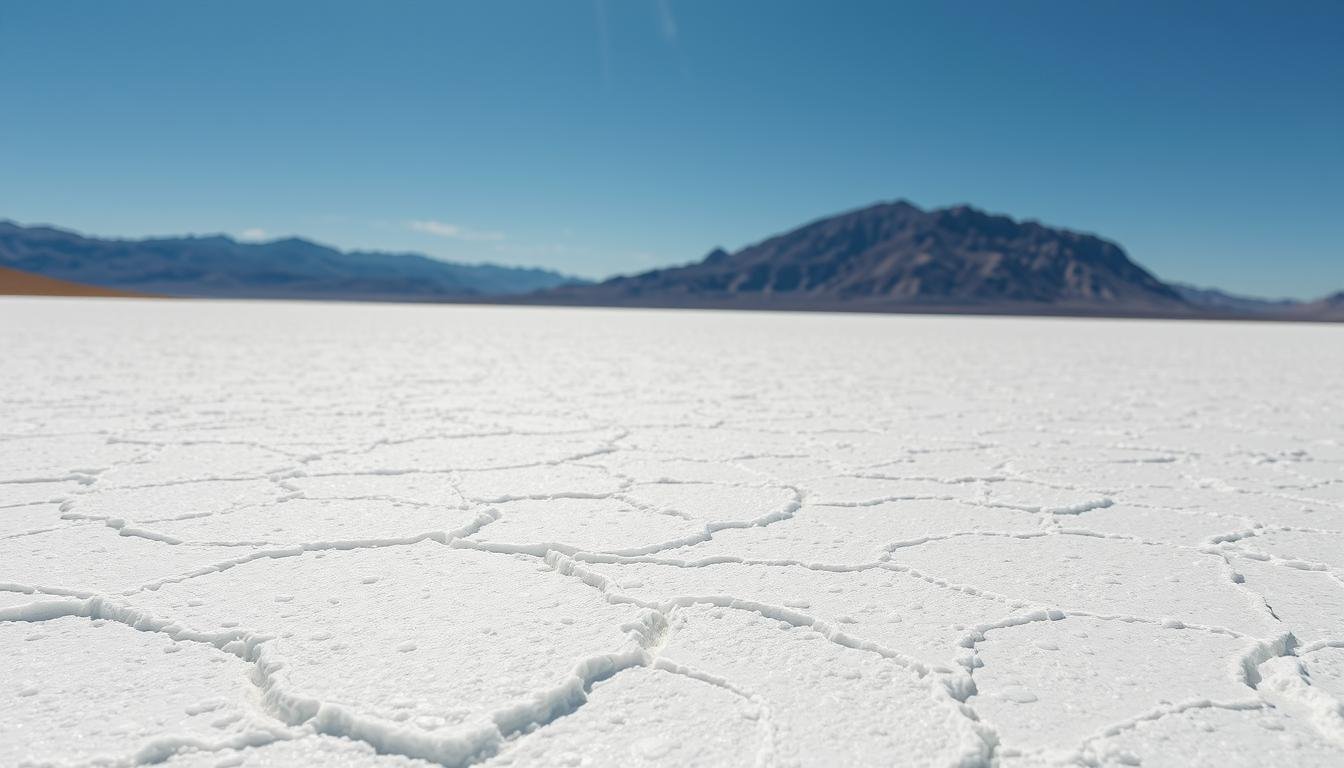Can You Eat Salt from Death Valley? Death Valley is a unique natural wonder known for its extreme climate and geological features. It has salt within the valley. The question is, is this Death Valley salt safe to eat?
Harvesting salt from the environment is tempting. But, it’s important to check if the salt is safe and pure. Salt is crucial for our health, but where it comes from matters a lot.
It’s key to know what’s in edible salt from Death Valley. This article will look into if salt from this area is safe to eat.
Contents
- 1 The Salt Formations of Death Valley
- 2 Composition of Death Valley Salt
- 3 Can You Eat Salt from Death Valley?
- 4 Potential Health Implications
- 5 Historical and Cultural Uses of Death Valley Salt
- 6 Understanding Death Valley Salt Edibility
- 7 FAQ: Can You Eat Salt from Death Valley?
- 7.1 Is the salt from Death Valley edible?
- 7.2 What are the impurities found in Death Valley salt?
- 7.3 How does Death Valley salt compare to regular table salt?
- 7.4 Can consuming Death Valley salt have health implications?
- 7.5 Are there any historical or cultural uses of Death Valley salt?
- 7.6 How is salt formed in Death Valley?
- 7.7 Is it safe to harvest salt from Death Valley?
The Salt Formations of Death Valley
Death Valley is home to fascinating salt formations. These are created by the area’s unique geological formations. Minerals accumulate here, forming a crust as water evaporates.
The salt crust in Death Valley forms mainly through water evaporation. Water from underground sources brings salts and minerals to the surface. As this water dries up, the salts and minerals are left behind, building a salt layer.
The appearance of these salt formations can change. They might look smooth and white or rugged and crystalline. The type of salt depends on the minerals in the water. Knowing what the salt is made of helps us understand its uses and effects.
Composition of Death Valley Salt
Death Valley salt is not like the salt you use in cooking. It has a unique mix of minerals. The salt in Death Valley is more than just sodium chloride. It’s a complex mix shaped by the area’s geological history.
Presence of Minerals and Impurities
The mineral content in Death Valley salt changes based on where you find it. Some spots have more minerals because of flooding and evaporation.
Minerals like calcium, magnesium, and potassium are common in Death Valley salt. These minerals come from the geological processes that have shaped the salt over time.
Death Valley salt also has impurities, unlike refined table salt. It keeps its natural minerals and substances. This makes it more ‘natural’ but also means it might have substances not found in regular salt.
Knowing what’s in Death Valley salt is key to understanding its health effects. Its unique mix of minerals and impurities make it different from regular salt. This raises questions about its safety for eating.
Can You Eat Salt from Death Valley?
Death Valley salt is a fascinating geological feature, but is it safe to eat? The salt formations in Death Valley are mostly halite, or sodium chloride, like table salt. But, just because they look similar doesn’t mean Death Valley salt is safe to eat.
Death Valley salt and table salt differ mainly in impurities. Death Valley salt, being natural, can have minerals and substances not in table salt. These can include calcium, magnesium, and potassium, and other harmful substances if eaten in large amounts.
Comparison with Table Salt
Table salt is refined to remove impurities, making it almost pure sodium chloride. Death Valley salt, on the other hand, is unrefined and can have many substances not found in table salt. Here’s a comparison:
| Characteristics | Death Valley Salt | Table Salt |
|---|---|---|
| Composition | Primarily sodium chloride with impurities | Almost pure sodium chloride |
| Refining Process | Unrefined, natural product | Refined to remove impurities |
| Mineral Content | May contain additional minerals like calcium and magnesium | Minimal mineral content |
Eating Death Valley salt could potentially lead to the ingestion of harmful substances. While the salt itself is not likely to cause immediate harm, eating it regularly or in large amounts could have health implications due to its impurities.
Potential Health Implications
Thinking about eating Death Valley salt? It’s key to know the health risks. Salt is vital for our bodies, but too much can cause problems like high blood pressure and kidney issues.
Death Valley salt is mostly sodium chloride, like regular salt. But, its mineral mix might differ, affecting health. Eating a lot of this salt could worsen high blood pressure.
Precautions for Safe Consumption
To safely eat Death Valley salt, follow these tips:
- Use it in small amounts, like any salt.
- Watch your salt intake from all foods.
- If you have health problems, talk to a doctor.
| Mineral | Death Valley Salt | Table Salt |
|---|---|---|
| Sodium Chloride | 95% | 99% |
| Iron | 0.5% | 0.01% |
| Calcium | 0.2% | 0.01% |

Knowing what Death Valley salt is and its health risks helps you decide wisely. Always eat it in moderation and seek doctor advice if needed.
Historical and Cultural Uses of Death Valley Salt
The natural salt in Death Valley has been used for centuries. It’s a big part of the area’s cultural history. You can learn how this natural resource has been used in many traditional ways. It shows its value beyond just being a geological feature.
Salt harvesting in Death Valley is a long-standing tradition. Many cultures have used this salt for both everyday needs and special ceremonies. The way to harvest salt has been passed down through generations. Over time, the methods have been improved to keep it sustainable.
Cultural Significance
The cultural importance of Death Valley salt is huge. It’s been used in many rituals and ceremonies. It stands for purification, protection, and bringing people together. You can see how deeply this natural salt is tied to the region’s culture.
Exploring the history of Death Valley salt reveals a wealth of cultural practices. This salt has been at the heart of community life. It has shaped local customs and ways of living.
Understanding Death Valley Salt Edibility
You now know a lot about Death Valley salt. It’s found in unique formations and has many uses. But, it’s important to check if it’s safe to eat because of possible contaminants.
Death Valley salt isn’t made for eating like regular salt. It has a rich history and cultural value. But, eating it might not be good for your health.
When you’re outdoors, it’s key to know what’s around you. Death Valley salt is best admired from afar. This way, you can enjoy the area’s beauty without risking your health.
See Also: Can You Eat the Skin of a Baked Potato?
FAQ: Can You Eat Salt from Death Valley?
Is the salt from Death Valley edible?
The salt from Death Valley is mostly sodium chloride, like table salt. But, its edibility is uncertain because of possible impurities and minerals.
What are the impurities found in Death Valley salt?
Death Valley salt may have minerals like calcium, magnesium, and potassium. These come from the environment around it.
How does Death Valley salt compare to regular table salt?
Death Valley salt is coarser than refined table salt. It also has a wider range of minerals, which can change its taste and texture.
Can consuming Death Valley salt have health implications?
Yes, eating Death Valley salt can be risky, especially in large amounts. This is because of its potential impurities and minerals.
Are there any historical or cultural uses of Death Valley salt?
Yes, salt from places like Death Valley has been used in many cultures and histories. It’s often for preserving food or in ceremonies.
How is salt formed in Death Valley?
Salt formations in Death Valley come from water evaporation. This leaves behind a salt crust and other minerals.
Is it safe to harvest salt from Death Valley?
Harvesting salt from Death Valley is possible. But, it’s important to know the local laws and take steps to avoid contamination.

Hello, I am Bellamy George, a certified nutritionist and food safety specialist from Springfield, IL. With a degree in Food Science, I share research-backed insights on edible foods, seeds, and seafood for safe, informed eating.

